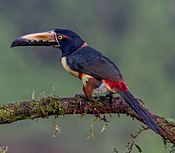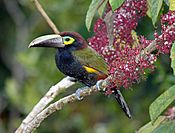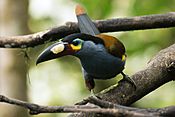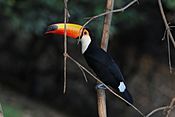Toucan facts for kids
Quick facts for kids Toucan |
|
|---|---|
 |
|
| Clockwise from top-left: Toco toucan (Ramphastos toco), Plate-billed mountain toucan (Andigena laminirostris), Chestnut-eared aracari (Pteroglossus castanotis), White-throated toucanet (Aulacorhynchus albivitta) | |
| Scientific classification |
|
| Kingdom: | Animalia |
| Phylum: | Chordata |
| Class: | Aves |
| Order: | Piciformes |
| Suborder: | Pici |
| Infraorder: | Ramphastides |
| Family: | Ramphastidae Vigors, 1825 |
| Genera | |
|
|
Toucans are colorful birds found in the tropical parts of America. They belong to a bird family called Ramphastidae. These birds are known for their bright colors and very large, often colorful, beaks. There are five main groups, or genera, of toucans, with over forty different species.
Toucans live in trees, which means they are arboreal. They usually lay 2 to 4 white eggs in their nests. They make their nests in tree hollows or holes made by other animals, like woodpeckers. A toucan's beak isn't very good for digging holes. When baby toucans hatch, they are completely naked, without any fluffy feathers. Toucans stay in one place and do not migrate to other areas. You can usually find them in pairs or small groups. Sometimes, they even "fence" with their beaks or wrestle. Scientists think they do this to figure out who is in charge. In Africa and Asia, birds called hornbills live in a similar way to toucans. This is an example of convergent evolution, where different animals develop similar traits.
Contents
About Toucans: Family and Names
The name "toucan" comes from the words tukana (in the Tupi language) or tukã (in the Guaraní language). These words came to English through Portuguese. The toucan family includes toucans, aracaris, and toucanets. Other birds related to them are barbets and woodpeckers.
Toucans: Different Groups
The toucan family has five main groups of birds that are alive today:
What Toucans Look Like

Toucans come in many sizes. The smallest is the lettered aracari (Pteroglossus inscriptus), which weighs about 130 grams (4.6 ounces) and is 29 centimeters (11 inches) long. The largest is the toco toucan (Ramphastos toco), weighing around 680 grams (1.5 pounds) and measuring 63 centimeters (25 inches). Their bodies are short and strong, similar in size to a crow. Their tails are rounded and can be half or even the full length of their body. They have short, thick necks. Their wings are small because they live in forests and only need to fly short distances.

Toucans have strong, short legs. Their toes are arranged in pairs, with two pointing forward and two pointing backward. Most toucans look the same whether they are male or female. However, the Selenidera group is different because males and females have different colors. This is why they are called "dichromatic toucanets." Female toucans usually have shorter, deeper, and sometimes straighter beaks than males. The largest toucans often have purple feathers with white, yellow, and red colors, and some black. Smaller toucans, called aracaris, have yellow undersides with black or red bands. Toucanets mostly have green feathers with blue marks.
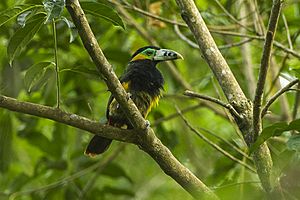
The most famous part of a toucan is its large, colorful bill. In some big species, the bill can be more than half the length of the bird's body! Even though it's big, the toucan's bill is very light. It's made of bone supports with a light, spongy material called keratin in between. The bill has small, tooth-like edges at the front. In the past, people thought toucans ate fish because of these edges. But now we know they mostly eat fruit. Scientists have found that the toucan's large bill helps it control its body temperature. It also helps them reach fruit far away without moving much, saving energy. Some people think the large bill might scare smaller birds, allowing the toucan to take eggs or babies from their nests. The beak also lets the bird reach deep into tree holes to find food that other birds can't get.
A toucan's tongue is long (up to 15 centimeters or 6 inches), narrow, grey, and has frayed edges. This helps it taste things better.
Toucans have a special way their tail bones are connected. The last three tail bones are joined together and attached to the spine with a special joint. This allows toucans to bend their tail forward until it touches their head. This is how they sleep, often looking like a ball of feathers with just the tip of their tail sticking out.
Where Toucans Live
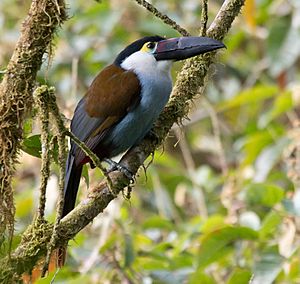
Toucans live in the Neotropics, which is a region from Southern Mexico, through Central America, and down into South America, reaching northern Argentina. They mostly live in warm, low-lying tropical areas. However, some mountain species from the Andigena group live in cooler climates high up in the Andes mountains, even near the tree line.
Most toucans are forest birds and prefer old, untouched forests. They might go into younger forests to find food, but they need forests with large, old trees that have big enough holes for them to nest in. Toucans don't travel well over water, so you won't find them in the West Indies. The only toucan that doesn't live in a forest is the toco toucan. It lives in savannahs with patches of forest and open woodlands.
How Toucans Live
Toucans are very social birds. Most species live in groups of 20 or more birds for most of the time. During the breeding season, pairs might leave the group to nest. After their babies hatch, they return to the group with their young. Larger groups can form when many toucans gather, like during migrations or around a tree with lots of fruit.
Toucans often spend time playing with their beaks, chasing each other, and calling out. They do this during the long time it takes for fruit to digest, which can be up to 75 minutes. These behaviors might help them keep their pair bonds strong or figure out who is in charge in the group.
What Toucans Eat
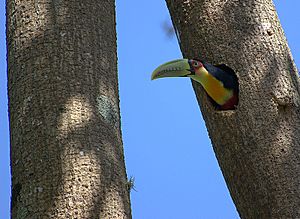
Toucans mainly eat fruit, which means they are frugivores. But they are also omnivores, meaning they will eat other things when they get the chance. They eat insects, smaller birds, and small lizards. Toucans kept in zoos have been seen actively hunting insects. They also raid the nests of smaller birds, taking their eggs and baby birds. This likely gives them important protein. Toucans especially like to feed animal food to their chicks. In their natural homes, toucans are the main fruit-eaters. Because of this, they play a very important role in spreading seeds from fruit trees.
Toucans and Their Nests
Toucans build their nests in holes in trees. Having suitable trees with holes is a must for toucans to live in an area. Most toucans do not dig their own nesting holes, though some green toucanets do.
Toucan Sounds
Toucans make many different sounds. The name "toucan" itself comes from a frog-like croaking sound they make. They also make barking and growling noises. They use their beaks to make tapping and clattering sounds. Mountain toucans are known for making sounds that sound like a donkey braying.
Toucans and People
Toucans are some of the most popular and well-known birds in the world because of their unique look. In the places where they live, people used to hunt them for food and keep them as pets. Their feathers and beaks were also used for decorations. In some areas, if you found a toucan nest, you were allowed to own and sell the birds inside. In the Western world, toucans became famous thanks to John Gould, who wrote detailed books about them. There's even a group of stars called Tucana in the sky, named after the toucan.
Toucans have been used a lot in advertising. In the 1930s and 1940s, Guinness beer ads featured a toucan because the bird's black and white colors matched the dark beer. A cartoon toucan named Toucan Sam has been the mascot for Froot Loops breakfast cereal for a long time. A toucan is also the mascot for the Brazilian Social Democracy Party in Brazil; its members are called tucanos because of this.
Toucans have also appeared in popular shows and games. They were the main characters in Toucan Tecs, a 1992 UK cartoon about two detective toucans named Zippi and Zac. In Dora the Explorer, a character named Señor Túcan is a Spanish-speaking toucan who sometimes helps Dora. Tuca, a main character in the 2019 show Tuca & Bertie, is a toucan. In the 2016 Nintendo 3DS game Pokémon Sun and Moon, the Pokémon Toucannon and its earlier forms were inspired by the Toco Toucan.
See also
 In Spanish: Tucanes para niños
In Spanish: Tucanes para niños



